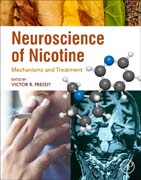
Neuroscience of Nicotine: Mechanisms and Treatment presents the fundamental information necessary for a thorough understanding of the neurobiological underpinnings of nicotine addiction and its effects on the brain. Offering thorough coverage of all aspects of nicotine research, treatment, policy and prevention, and containing contributions from internationally recognized experts, the book provides students, early-career researchers, and investigators at all levels with a fundamental introduction to all aspects of nicotine misuse. With an estimated one billion individuals worldwide classified as tobacco users-and tobacco use often being synonymous with nicotine addiction-nicotine is one of the world's most common addictive substances, and a frequent comorbidity of misuse of other common addictive substances. Nicotine alters a variety of neurological processes, from molecular biology, to cognition, and quitting is exceedingly difficult because of the number of withdrawal symptoms that accompany the process. Integrates cutting-edge research on the pharmacological, cellular and molecular aspects of nicotine use, along with its effects on neurobiological functionDiscusses nicotine use as a component of dual-use and poly addictions and outlines numerous screening and treatment strategies for misuseCovers both the physical and psychological effects of nicotine use and withdrawal to provide a fully-formed view of nicotine dependency and its effects INDICE: Part 1: General Aspects of Nicotine Usage 1. History of tobacco usage 2. Substance use disorders and the position of nicotine 3. Tobacco use in different countries 4. Smokeless tobacco use (to cover e cigarettes) and nicotine 5. Health risks of snus 6. Cigarette design and nicotine in smoke 7. Nicotine use in communities 8. Smoking and alkaloids with nicotinic-like effects 9. Gender and nicotine 10. Smoking behaviour in subjects with disease: a focus on HIV 11. The future of smoking Part 2: Effects of Nicotine on Neurobiological Function and Features 12. Dopamine release in the striatum and nicotine 13. Ventral tegmental area dopamine neurons and nicotine 14. Neurology of nicotinic acetylcholine receptors and Parkinson's disease 15. Smoking and neurodegeneration and the role of nicotine 16. Prenatal nicotine exposure and neuronal progenitor cells 17. Postsynaptic nicotinic acetylcholine receptor subunits in neurons 18. Nicotine and mRNA in neurons Part 3: Psychology and Behaviour 19. Psychiatric conditions and nicotine addiction: an overview 20. Nicotine use in attention deficit/hyperactivity disorder 21. Schizophrenia and nicotinic acetylcholine receptors in nicotine addiction 22. Nicotine and posttraumatic stress symptoms 23. High-risk smoking behaviors 24. Cigarette smoking and obsessive-compulsive features 25. Nicotine and the hypothalamic-pituitary-adrenal axis: Implications for psychology 26. Nicotine and appetite 27. Cues and cigarette-related images Part 4: Pharmacology and Neuropharmacology 28. Nicotine dependence and the dopaminergic system 29. Metabolism of nicotine and cotinine (a metabolite of nicotine) 30. Alpha-7 nicotinic acetylcholine receptors and pain 31. p38-dependent effects of nicotine and tau 32. Nicotine and metabotropic glutamate receptor-5 33. 18-Methoxycoronaridinand, medial habenula and sensitization to nicotine 34. Pharmacology of muscle-type nicotinic receptors 35. Role of nicotinic receptors and synaptic plasticity 36. Agonists and allosteric modulators of the alpha7 nicotinic ACh receptor Part 5: Withdrawal and Craving 37. fMRI neurofeedback and craving in nicotine dependence 38. N-acetylcysteine as a means to reduce nicotine withdrawal 39. Withdrawal regulation training 40. Withdrawal and hippocampal nAChR 41. Neurobiological aspect of alcohol and nicotine and in terms of withdrawal 42. Nicotine withdrawal and psychosocial stresses 43. Tobacco withdrawal and responses of different groups and populations 44. Craving and withdrawal Symptoms in pregnancy 45. Measures of nicotine craving and applications Part 6: Nicotine as a Component of Dual-use and Poly Addictions 46. Nicotine and alcohol 47. Relationship between cannabis and tobacco cigarette use 48. Nicotine exposure and cocaine reward 49. Nicotine and methamphetamine 50. Personality profiles in marijuana and nicotine users 51. Risk profiles of poly tobacco Part 7: Cellular Effects and Molecular Biology of Nicotine 52. Smoking within the context of genome-wide analysis 53. Transcription and L-type calcium channels by nicotine 54. The alpha3beta4alpha5 nicotinic receptor 55. The TRPM4-SLC6A16 gene and nicotine addiction 56. The cell membrane and nicotinic acetylcholine receptor subtypes 57. Brain gene expression in the context of nicotine rewards 58. Neurotensin and nicotine Part 8: Screening and Markers 59. LC-MS/MS method for simultaneous determination of nicotine and its metabolite cotinine (a metabolite of nicotine) 60. Urinary cotinine measures and applications to the community 61. The young and smoke exposure assessed by urinary cotinine (a metabolite of nicotine) 62. The 3'-hydroxycotinine to cotinine ratio and applications 63. The Wisconsin Inventory of Smoking Dependence Motives (WISDM)) and applications Part 9: Treatments and Strategies for Nicotine Addiction and Related Features 64. Reduction of nicotine in tobacco and impact 65. Tobacco cessation clinical practices and receptivity 66. Nicotine addiction via smokeless tobacco and cessation 67. Use of nicotine patches in smokers 68. Pharmacist-managed tobacco cessation clinic 69. Varenicline for smoking cessation 70. Smoking Cessation Counseling 71. Perceptions about nicotine in the context of replacement therapies 72. Relapse to smoking in quitters 73. Social support and smoking quitters 74. Smoking cessation and smoking cessation counseling Part 10: Policy Aspects 75. International aspects of treating tobacco dependence 76. The policy of European tobacco control 77. E-cigarettes and policy 78. Rolling of tobacco and policy 79. Smoke-free policies 80. Graphic cigarette warning labels 81. Cigarette packaging
- ISBN: 978-0-12-813035-3
- Editorial: Academic Press
- Encuadernacion: Rústica
- Páginas: 608
- Fecha Publicación: 01/03/2019
- Nº Volúmenes: 1
- Idioma: Inglés
